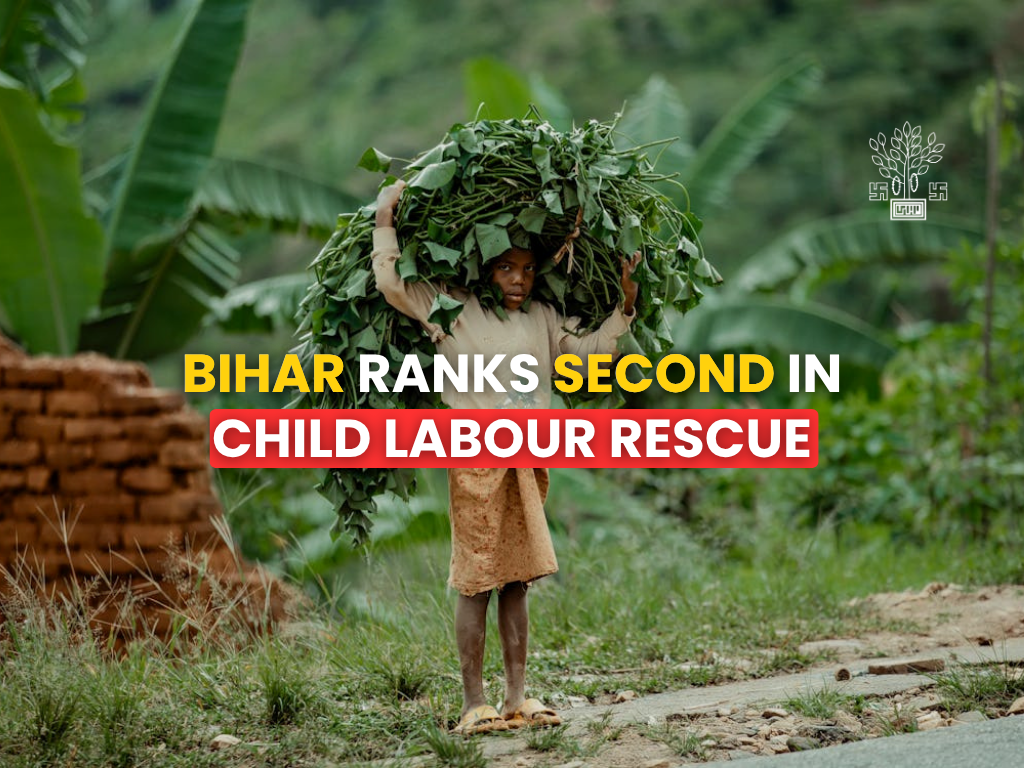Bihar Child Labour Rescue: India’s 2nd Biggest Operation Frees 3,974 Kids

Bihar Child Labour Rescue Mission 2025 has been a success with a total of 3,974 children rescued during the year 2024–25. According to a recent report by ‘Just Rights for Children’ (JRC), Bihar has secured the second position in the country in terms of child labour rescue operations. Apart from this, the Bihar government has introduced a policy in which every rescued child will be given ₹25,000 to prevent re-trafficking.
We have covered everything about the Bihar Child Labour Rescue mission in this article including data-backed reports, policy updates, and the roadmap for rehabilitation. You can use the following Table of Contents to navigate as per your preference:
Table of Contents
Bihar Child Labour Rescue Mission 2025
Bihar has rescued 3,974 children from exploitative labour conditions in 2024-25. This makes Bihar the second Indian state in child labour rescue, after Telangana were over 11,000 children were rescued. This comes under the central government’s initiative of rescuing children from child labour under the Bachpan Bachao Andolan.
According to the JRC report, most of the children were found in inhumane conditions in brick kilns, roadside eateries, and unregulated factories. But, freeing the children from oppression and exploitative working conditions is the first step. The government must focus on preventive measures, so that, the children do not re-enter into the labour system and environment.
Tracking System Enhances Rescue Efforts
Rajesh Bharti, who is the Secretary-cum-Labour Commissioner informed about the Bihar government’s proactive approach. He stated that Bihar is the first Indian state to implement a Child Labour Tracking System (CLTS). This digital tool helps in keeping records of the rescued children, prevent re-trafficking and track their rehabilitation progress.
₹25,000 for Every Bihar Child Labour Rescue
What’s appreciable about Bihar Child Labour Rescue operations is that every rescued child is granted ₹25,000 as direct financial aid. It is distributed from the CM relief fund and it makes Bihar the first state to introduce such an initiative. This amount is very crucial for the reintegration of the rescued children into the society.
Their rehabilitation must be sustainable therefore authorities are granting the monetary aid. In the cases where families push their children into child labour, this amount will ensure that their children do not re-enter the labour system. The government is also planning to give mental health assistance to the rescued children along with education and nutrition.
Children Rescued from Worst Forms of Labour
The 90% children who got rescued in the Bihar Child Labour Rescue Mission were working in extremely hazardous and inhumane conditions. They were engaged in “worst forms of child labour.” Long shifts at brick kilns, exposure to harmful chemicals at unorganised factories, unregulated domestic labour and in hotel kitchens – these things have been categorised as the worst forms of labour by the International Labour Organization (ILO) and the Indian government.
Such inhumane working conditions inflict lifelong trauma, injuries and health conditions on the children. So, such raids were crucial and there is an aim to increase them even further.
Public Awareness is Key
Ashok Kumar, who is the Chairman of the Bihar State Child Labour Commission, and Arvind Kumar Singh, the Commission’s Vice-Chairman, highlighted that this mission should go beyond official actions. Arvind Kumar Singh stressed upon the needs for collaboration between different sectors like academic institutions, NGOs, and media platforms. He also advised that public campaigns must be held to inform families about the dangers and illegality of child labour.
Awareness is the first step to prevention. In economically deprived families, it is very commonly seen that the parents themselves push their children into labour. This is primarily due to lack of education and information about government schemes. IEC (Information, Education, Communication) drives are being conducted as a part of the Bihar Child Labour Rescue campaign to address such issues. Moreover, awareness about India’s Right to Education is important, it is a fundamental right of every Indian citizen.
Rehabilitation Is the Real Test
Civil society groups have have suggested that the Bihar Child Labour Rescue mission must shift it’s focus on sustainable rehabilitation as well. According to the JRC report, it is evident that the children who have been freed from labour often face gaps in education, healthcare and social acceptance. So, the authorities need to focus on alleviating the rescued children from these problems as well.
The JRC report recommends a system that will track each rescued child and his/her reintegration into the mainstream society. State-level monitoring is required, otherwise without it, there is a risk of re-trafficking. Bihar Government’s labour Department is already designing district-level rehabilitation blueprints for addressing these issues.
Conclusion
The Bihar Child Labour Rescue mission can be seen as a roadmap and the national model for rescuing innocent children from the trap of inhumane working conditions. Bihar comes second to Telangana in the overall India ranking with 3,974 children rescue in just one year. And the fact that Bihar is the first state to introduce a policy relating to this is commendable. With the child tracking system, monetary aid for each child and the increased number of rescue raids Bihar is truly leading the nation in the rescue game. Such issues need to be treated with urgency and care.
However, for these missions to be completely successful, they will have to be continued on the same pace every year. And hopefully one day we will be able to achieve a child-labour free state. But the strategy must go beyond rescue operations – the children must be protected from further exploitation. Their education and rehabilitation must be the priority. With a meeting scheduled in July, we can hope for these issues to be resolved.
Recently, the Bihar government has announced that 9 ethanol plants will be operational in Bihar by 2026. If you missed that report, you can access it here.

I’m a final-year engineering student with a deep interest in current affairs, politics, and international issues. Writing news is my part-time passion, where I focus on sharing credible and well-researched stories. Every article I publish is backed by verified sources and multiple levels of fact-checking to ensure accuracy and trustworthiness.






Sad reality